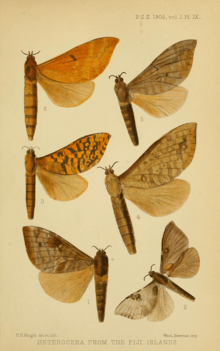Phassodes
Phassodes is a moth genus of the family Hepialidae. As of 2018, it is monospecific, consisting of the sole species Phassodes vitiensis; this species is very variable. It is found in Fiji and Samoa.[4] The life cycle is unknown but the larva is presumed to feed underground on the roots of plants or decaying matter.[5]
| Phassodes | |
|---|---|
 | |
| Six specimens from Viti Levu, Fiji | |
| Scientific classification | |
| Kingdom: | Animalia |
| Phylum: | Arthropoda |
| Class: | Insecta |
| Order: | Lepidoptera |
| Family: | Hepialidae |
| Genus: | Phassodes Bethune-Baker, 1905[1] |
| Type species | |
| Phassodes odorevalvula Bethune-Baker, 1905[1] | |
| Species | |
| |
| Synonyms[2] | |
|
Species: | |
Taxonomic history
The British entomologist George Thomas Bethune-Baker first circumscribed the genus Phassodes in 1905. He included six species, all of which he described in the same work.[1] In 1950, the French entomologist Pierre Viette synonymized Bethune-Baker's P. nausori with P. vitiensis;[6] P. vitiensis was first described by Walter Rothschild in 1895.[3]
gollark: Actually, I own it.
gollark: You say that like it's possible!
gollark: Unfortunately, I literally cannot leave, as that requires right-clicking.
gollark: Did you know? I find it marginally funny that when I make a point or have an opinion on something, people disagree and when I explain it they call me stupid and tell me to shut up even though I have made a valid point and try and present the idea that I am arrogant and trying to act smart. I point out that I have make no claim to being smart and also point out flaws in their methods, they ignore all the things I have said and just remember everything that has occurred as a reason to call me stupid, arrogant and lacking in social skills.
gollark: This is, of course, how time works.
References
- Bethune-Baker, G. T. (1905). "Notes on a small Collection of Heterocera from the Fiji Islands, with Descriptions of some New Species". Proceedings of the Zoological Society of London. 1905 (1): 89–92. doi:10.1111/j.1469-7998.1905.tb08365.x; Pl. 9, Figs. 1–6.
- Nielsen, Robinson & Wagner (2000), p. 859.
- Rothschild, Walter (1895). "On Two New Moths and an Aberration". Novitates Zoologicae. 2 (4): 482.
- Nielsen, Robinson & Wagner (2000), p. 824, 831.
- Grehan, John R. (2010). "Structural variants in the morphology of the first abdominal tergite supporting the monophyly of the Latin American genera Cibyra Walker, Druceiella Viette, Pfitzneriella Viette and Trichophassus Le Cerf (Lepidoptera: Hepialidae)" (PDF). Bulletin of the Buffalo Society of Natural Sciences. 39: 46.
- Viette, Pierre E. L. (1950). "Contribution to the Study of Hepialidae (9th Note): The Genus Phassodes Bethune-Baker (Lepidoptera)". Proceedings of the Hawaiian Entomological Society. 14 (1): 189–190. hdl:10125/16224.
Works cited
- Nielsen, Ebbe S.; Robinson, Gaden S.; Wagner, David L. (2000). "Ghost-moths of the world: a global inventory and bibliography of the Exoporia (Mnesarchaeoidea and Hepialoidea) (Lepidoptera )" (PDF). Journal of Natural History. 34 (6): 823–878. doi:10.1080/002229300299282. Archived from the original (PDF) on 2016-03-11. Retrieved 2016-06-18.CS1 maint: ref=harv (link)
External links
- Grehan, John (2018). "Hepialidae: Phassodes Bethune-Baker, 1905". Hepialidae (ghost moths) and other Exoporia of the world. Archived from the original on 27 February 2018.
This article is issued from Wikipedia. The text is licensed under Creative Commons - Attribution - Sharealike. Additional terms may apply for the media files.